
What are polymers for use in wastewater treatment?
Per Arne Jordbræk, Pajco Consult
Nr.1 2023
UN report 2023; Water shortages affect billions of people, animals and plants. The number of affected individuals is growing strongly in line with an ever-increasing population. Water shortages are very likely to trigger a global crisis.

This article can be downloaded as a PDF at the Fjell Tech agenda homepage - Download center.
Only approx. 0.07% of the world’s fresh water bodies are readily available. The water we consume usually needs to be cleaned before we can use it, and it needs to be cleaned after we have polluted it.
We pollute almost 100% of all the water we humans consume. The exception is leakage water and water for agricultural and power production. In line with reduced access to water and an in- creasingly polluted sea, the need for purification and reuse of water increases.
Purification of water consists of 2 basic functions;
- Drag the waterborne pollutants out of the water
- Concentrate/extract the contaminants to reduce the disposal volume.
For both of these functions, the use of polymer is critically important. Without polymer, the world would very quickly drown in its own water-borne waste.
Polymer collects finely fractionated particu- late material that is distributed in the water into larger units (flocs). A phase separation is established, respectively lumped solid and a repelled water phase.
This makes it possible to separate particles from water in a very efficient way in relation to degree of purity, time consumption and footprint. In addition, polymer is used both for thickening and dewatering the sludge that the water treatment produces.
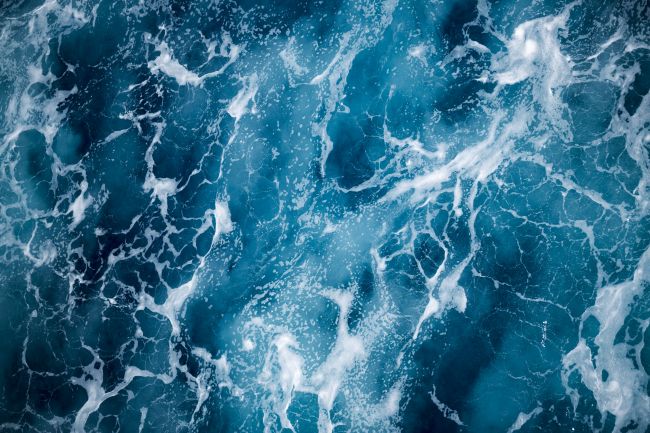
Clean running surface water. A resource that some can only dream of.
What is polymer / polyacrylamide (PAM)?
Polymer is an unvarnished popular term for the water-soluble polyelectrolyte “PolyAkrylaMid”.
The word polymer is of Greek origin and means many parts/joints. The term is used to describe how natural or synthetic materials are built up at the molecular level. Natural polymers are found in all living things, while synthetic polymers are found in almost everything we make and surround ourselves with.
Polymer is thus a general term for all plastic and rubber materials.
Polyacrylamide is a plastic material and a type of polymer that differs from other plastic materials by being water-soluble and able to act as “chemical magnets” in water/sludge.
The water solubility contributes to the molecular chains being dispersed (spread) effectively in the medium to which it is added, whether it is a water or sludge phase.
When PAM is dissolved in water, the individual molecular chains acquire an ionic charge (surplus or deficit of electrons) which attracts water-borne material (particles) with the opposite surface charge.
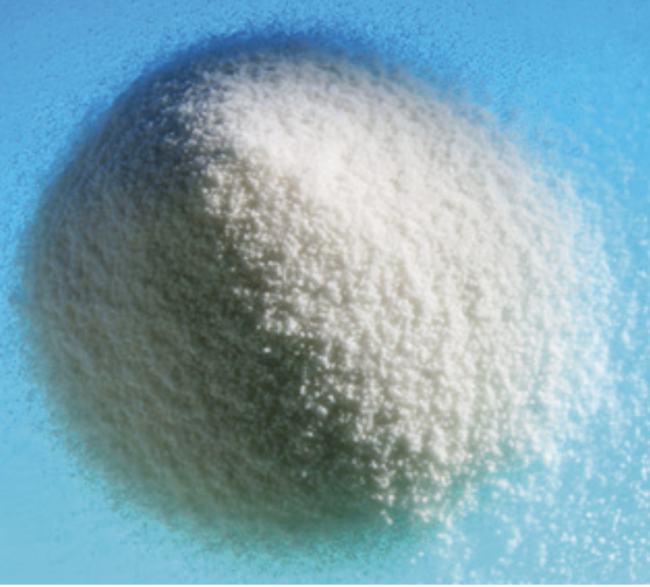
PAM is supplied as a powder, liquid emulsion or as a water-diluted solution.
The different types of PAM can, simply put, be more or less anionic (negatively charged) or cationic (positively charged). In addition, the
different charge levels can be tailored with different properties. This gives a very large selection of different PAM qualities. As every water and sludge phase is relatively unique in a chemical sense, choosing the right type of PAM and the best user conditions are central to function and results. This mapping includes chemical lab tests with process engineering adaptation, and it must be carried out by the chemical suppliers or others with similar expertise.
A polymer is formed by “polymerizing” one or more types of “monomer” (single molecule units). The polymerization process “hooks together” the monomer(s) and forms a long molecule, a polymer. Acrylamide (C3H5NO) is the monomer that is synthetically polymerised/converted to become polyacrylamide.
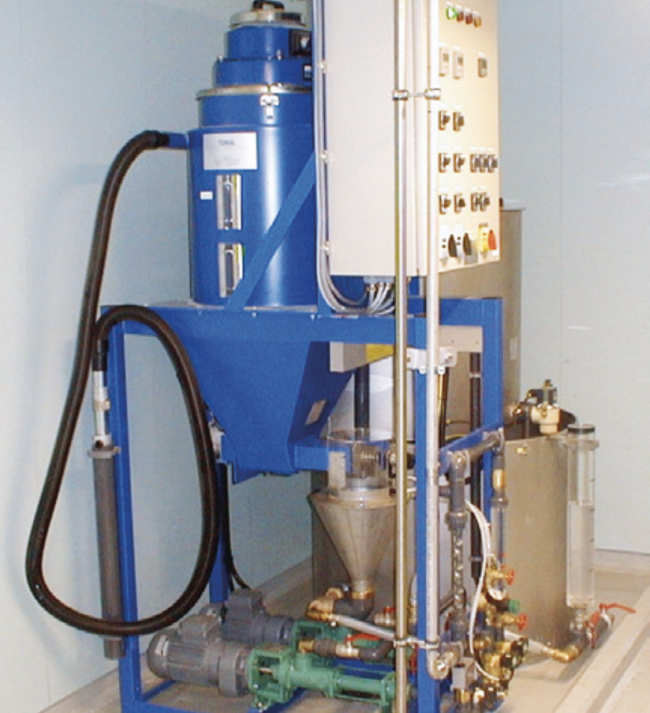
Example of polymer preparation device for powder PAM.
The actual polymerization process of acrylamide is never 100%, but usually over 99.9%.
The PAM we use for wastewater and sludge treatment therefore contains a small proportion of acrylamide monomer, typically and in accordance with the requirements relating to labeling obligations, below 1000 ppm (0.1%). When PAM is used for the purification of drinking water, the requirement is below 200 ppm (0.02%) of the monomer.
The polymer PAM is not considered to be dangerous, but the monomer, Acrylamide, which is the building block of PAM involves health risks linked to the fact that it is toxic and carcinogenic. As described, there are very strict limits on the amount of permitted residual monomer in a polymer product. If the powder form of polymer is used, great focus should still be placed on HSE measures and routines to prevent the operator from inhaling the powder. A safe choice can then be to use liquid polymer (ready-mixed emulsion) instead of the powder form.
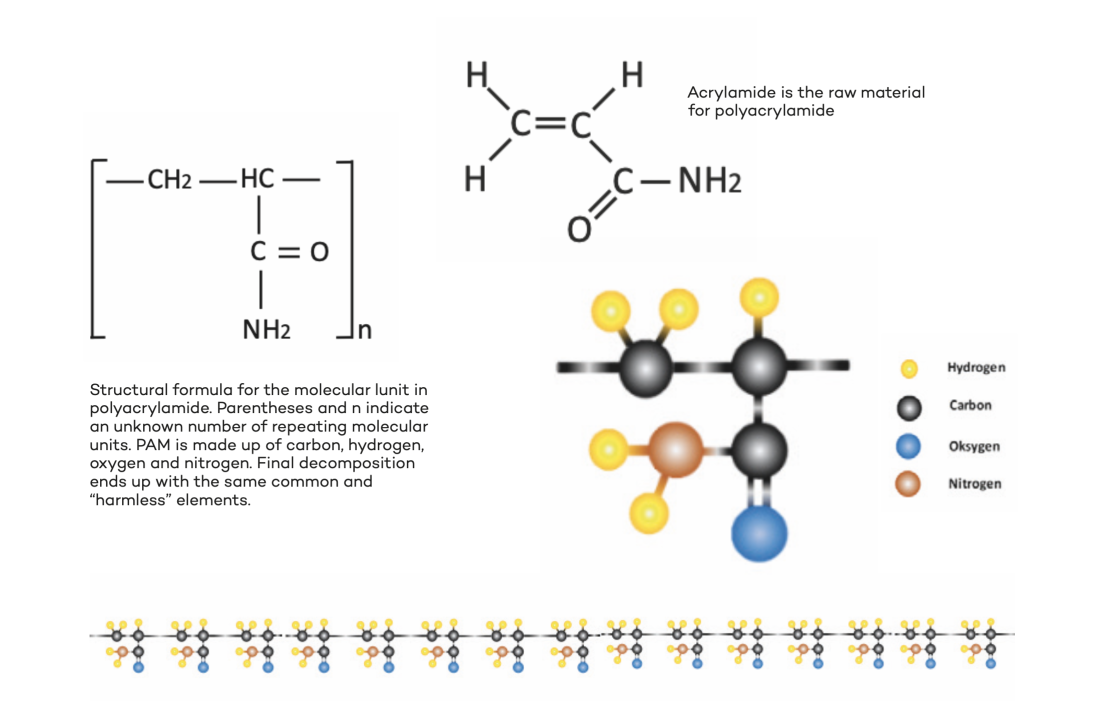
Molecular structure of PAM monomer and polymer.
Polyacrylamide has up to millions of units and forms molecular “strings”. The molecules are to be considered very large and heavy. This makes them slowly biodegradable. Shear forces, sunlight, ozone, chemical conditions and time first break the chains across, then the monomer link splits and finally the molecule decomposes atomically.
What is PAM used for?
PAM’s main function is to bind particulate solids that are suspended in liquid solution.
The binding force is used to separate the dry matter from the water phase or vice versa via mechanical/hydraulic machines and process interfaces.
The difference in separating dry matter from water with or without PAM is very large in relation to technical efficiency, time and footprint of the wastewater treatment plant.
In addition, PAM is an absolutely necessary binder for thickening and dewatering the sludge generated from the water treatment.
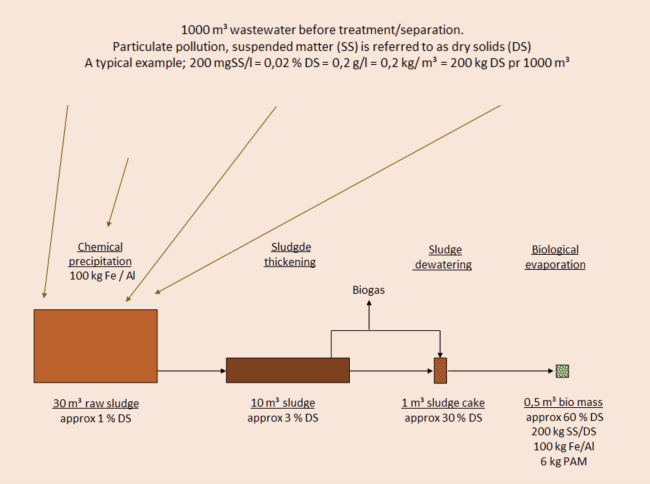
A graphic representation of how water-borne pollutants in a 1000 m3 volume (outer square) are concentrated. The sludge cake of approx. 1 m3 makes up 0.1% of the original volume, i.e. a volume reduction of 99.9% In most cases, the biomass is nutritious and well suited for soil improvement. PAM is absolutely central to effective felling, thickening and dewatering.
Flocculation in the sludge phase is used for thickening and dewatering. Thickening is done either statically or mechanically, while dewatering is mostly done mechanically. Neither PAM nor acrylamide monomer is bioaccumulative.
PAM is slowly biodegradable, while acrylamide (the monomer) is converted and decomposes quickly. PAM in thickened and dewatered sludge is primarily broken down by sunlight, ozone, shear forces and microbes.
The breakdown itself takes place in stages by first breaking down the molecular chains “across”, i.e. breaking them up. Then along the chains and finally the molecular remains are decomposed into their original elements. The degradation time is determined by the conditions to which the extract is exposed.
PAM does not prevent utilization of the extract in relation to energy production or soil improvement. In addition, it is an important fact that the raw materials PAM is made from can be taken up by plants, and that PAM when it is not degraded is not taken up by plants from the soil. PAM is added and used as dispersed molecules and must therefore not be confused with micro- or nanoplastics, which are solid molecular structures in small and even smaller aggregated units.

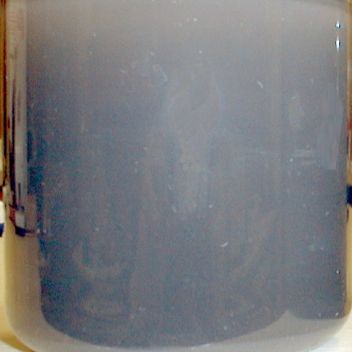
Image 1. Untreated zero sample. The particles are so small that they do not sinks to the bottom.
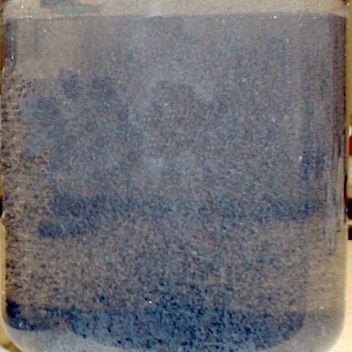
Image 2. The left beaker (Image1) has been added with 0.5 ppm of PAM. Stirred for approx. 30 seconds. The flocculation establishes a phase separation.

Picture 3. Middle beaker (picture2) a few seconds after stoppingstirring. High sinking speed provides efficient separation.
Much development work has been and is still being done globally to avoid or reduce the use of PAM. This has been driven by economic and environmental considerations. PAM represents a cost factor and is a synthetic plastic material.
The development has gone in many different directions such as; alternative chemicals, different mechanical solutions and new biological turnover processes. Much of the results contribute to reduced consumption, but all global water-related environmental activities are still, and will be for the foreseeable future, completely dependent on PAM.
To conclude, it is hardly an exaggeration to claim that polyacrylamide is the biggest chemical engineering contributor to sustainability related to humanity’s water consumption.

Picture 4. Untreated 0 sample (organic sludge) Dry matter approx. 4-5%. Very difficult to separate dry matter from water.

Picture 5. Left beaker (picture 4) added approx. 50 ppm with PAM. Strong flocculation and good phase separation.
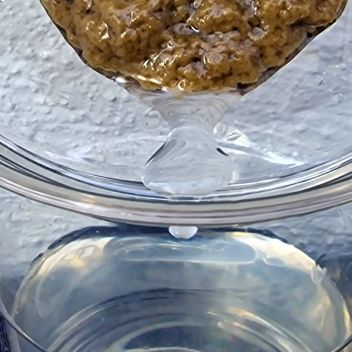
Picture 6. The flocculated sludge drains the water phase effectively.

Per Arne Jordbræk, Pajco Consult
Per Arne Jordbræk is a qualified engineer with lifelong professional experience related to wastewater treatment. He currently has his own consulting company, PAJCO, which offers separation technical service in lab and full scale, as well as planning and consulting in the field of chemical/mechanical separation for industrial and municipal water and sludge treatment.